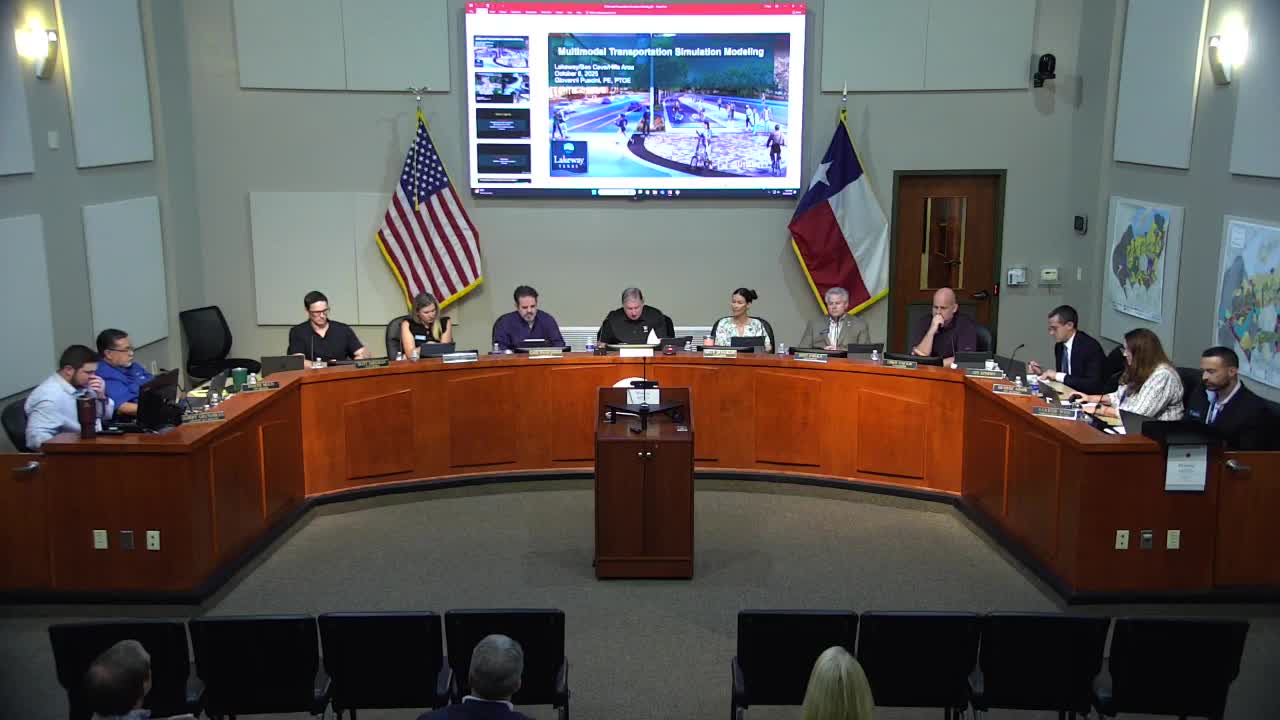Council hears proposal for regional "digital twin" traffic model; asks staff for more study and regional coordination
October 06, 2025 | Lakeway, Travis County, Texas
This article was created by AI summarizing key points discussed. AI makes mistakes, so for full details and context, please refer to the video of the full meeting. Please report any errors so we can fix them. Report an error »

Lakeway council members heard a presentation on Oct. 6 proposing a micro-simulation traffic model (a “digital twin”) of the RM 620/State Highway 71 corridor to analyze congestion, signal timing and development impacts. The council requested more staff study, regional coordination and an initial staff follow-up before any funding commitment.
Council member Joseph O’Brien introduced the concept and invited Giovanni Puccini of Quiddity Engineering to show recent examples of high-fidelity traffic micro-simulation. Puccini described how calibrated models use detector counts and commercial GPS-based datasets to reproduce vehicle and bicyclist movements and to test changes such as signal timing, lane closures and proposed geometric changes. He said cities can obtain datasets from providers such as INRIX and Replica and that Quiddity can provide engineering services and software licensure as part of an engagement.
A member of the public, Michelle Hazen, urged the council to avoid "black-box" AI and recommended transparency safeguards: publish model cards, disclose training data and inputs/outputs, maintain base counts for calibration, require human-interoperable backups and protect against vendor data bias. Hazen asked that any model used for land-use decisions include summer and holiday weekend peaks and make assumptions auditable.
Council discussion focused on next steps rather than immediate approval. Members suggested forming a small working group, conferring with TxDOT and regional partners (Bee Cave, Travis County) and asking staff for a refined scope and cost estimate. Council did not approve funding on Oct. 6; the meeting record shows the item was left on the table for further staff work and additional briefings with regional stakeholders.
Council member Joseph O’Brien introduced the concept and invited Giovanni Puccini of Quiddity Engineering to show recent examples of high-fidelity traffic micro-simulation. Puccini described how calibrated models use detector counts and commercial GPS-based datasets to reproduce vehicle and bicyclist movements and to test changes such as signal timing, lane closures and proposed geometric changes. He said cities can obtain datasets from providers such as INRIX and Replica and that Quiddity can provide engineering services and software licensure as part of an engagement.
A member of the public, Michelle Hazen, urged the council to avoid "black-box" AI and recommended transparency safeguards: publish model cards, disclose training data and inputs/outputs, maintain base counts for calibration, require human-interoperable backups and protect against vendor data bias. Hazen asked that any model used for land-use decisions include summer and holiday weekend peaks and make assumptions auditable.
Council discussion focused on next steps rather than immediate approval. Members suggested forming a small working group, conferring with TxDOT and regional partners (Bee Cave, Travis County) and asking staff for a refined scope and cost estimate. Council did not approve funding on Oct. 6; the meeting record shows the item was left on the table for further staff work and additional briefings with regional stakeholders.
View full meeting
This article is based on a recent meeting—watch the full video and explore the complete transcript for deeper insights into the discussion.
View full meeting
